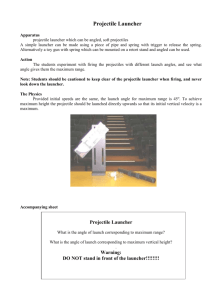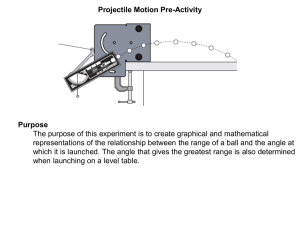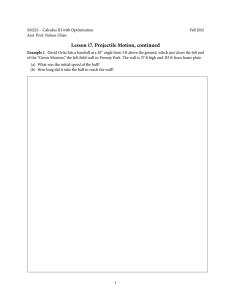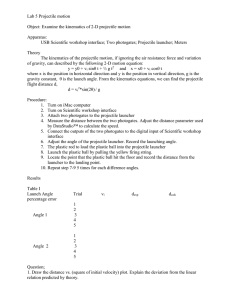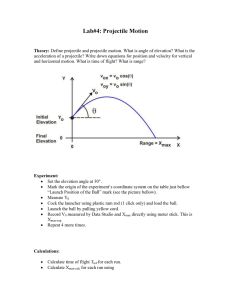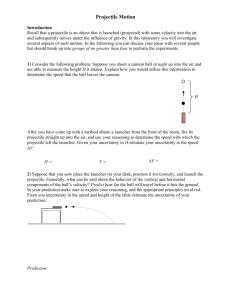Hit the Target
advertisement
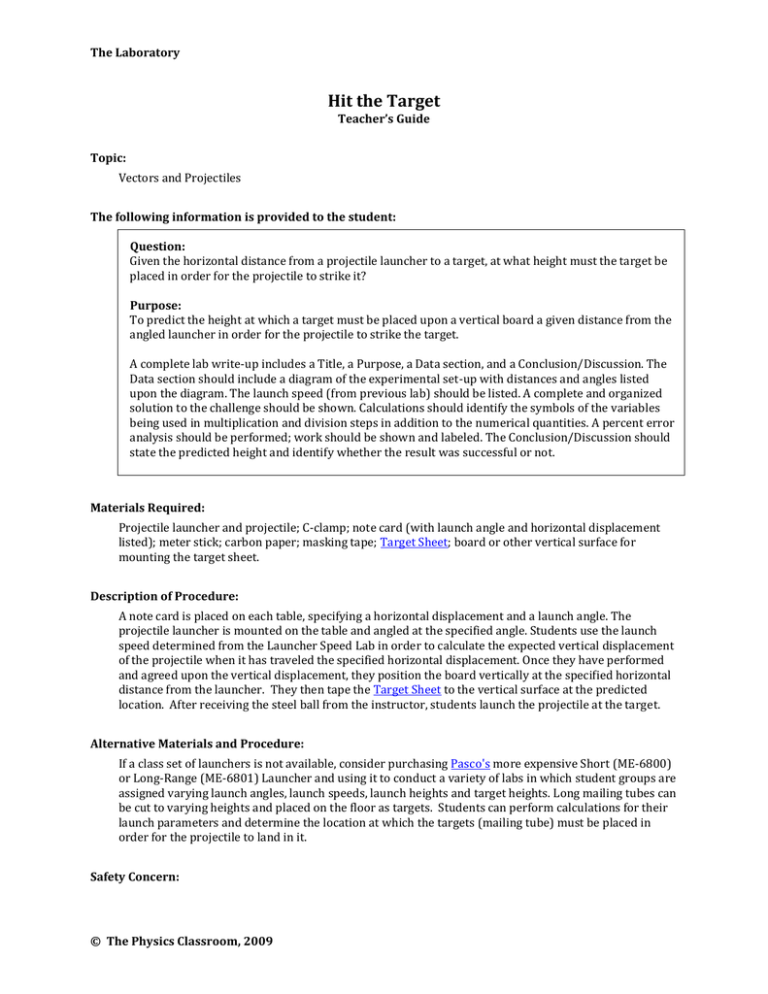
The Laboratory Hit the Target Teacher’s Guide Topic: Vectors and Projectiles The following information is provided to the student: Question: Given the horizontal distance from a projectile launcher to a target, at what height must the target be placed in order for the projectile to strike it? Purpose: To predict the height at which a target must be placed upon a vertical board a given distance from the angled launcher in order for the projectile to strike the target. A complete lab write-up includes a Title, a Purpose, a Data section, and a Conclusion/Discussion. The Data section should include a diagram of the experimental set-up with distances and angles listed upon the diagram. The launch speed (from previous lab) should be listed. A complete and organized solution to the challenge should be shown. Calculations should identify the symbols of the variables being used in multiplication and division steps in addition to the numerical quantities. A percent error analysis should be performed; work should be shown and labeled. The Conclusion/Discussion should state the predicted height and identify whether the result was successful or not. Materials Required: Projectile launcher and projectile; C-clamp; note card (with launch angle and horizontal displacement listed); meter stick; carbon paper; masking tape; Target Sheet; board or other vertical surface for mounting the target sheet. Description of Procedure: A note card is placed on each table, specifying a horizontal displacement and a launch angle. The projectile launcher is mounted on the table and angled at the specified angle. Students use the launch speed determined from the Launcher Speed Lab in order to calculate the expected vertical displacement of the projectile when it has traveled the specified horizontal displacement. Once they have performed and agreed upon the vertical displacement, they position the board vertically at the specified horizontal distance from the launcher. They then tape the Target Sheet to the vertical surface at the predicted location. After receiving the steel ball from the instructor, students launch the projectile at the target. Alternative Materials and Procedure: If a class set of launchers is not available, consider purchasing Pasco's more expensive Short (ME-6800) or Long-Range (ME-6801) Launcher and using it to conduct a variety of labs in which student groups are assigned varying launch angles, launch speeds, launch heights and target heights. Long mailing tubes can be cut to varying heights and placed on the floor as targets. Students can perform calculations for their launch parameters and determine the location at which the targets (mailing tube) must be placed in order for the projectile to land in it. Safety Concern: © The Physics Classroom, 2009 The Laboratory There is always a higher than usual level of risk associated with working in a science lab. Teachers should be aware of this and take the necessary precautions to insure that the working environment is as safe as possible. Goggles should be worn by all members of a lab group to prevent eye injury from accidental collisions with the projectile. Students should never look down the muzzle of the launcher. Care should be taken at all times when launching the projectile. Student horseplay and off-task behaviors should not be tolerated. Suggestions, Precautions, Notes: 1. 2. 3. 4. 5. 6. 7. Pasco Scientific sales a mini-launcher (ME-6825A) which comes with a steel ball, a plumb bob and a built-in protractor scale. The launcher can launch the steel ball at three different speeds and at multiple angles (including downwards, thanks to a magnet which holds the ball in place as the muzzle is pointed downward). While pricey, it is Pasco's least expensive launcher. Avoid losing the steel balls; a hefty price will be paid for their replacement. The launch speed of the projectile launcher was determined in the Launcher Speed Lab. Angling the launcher upward does not make an appreciable change in the launch speed. Students should be sure to use the same launcher which they used in the Launcher Speed Lab. The initial height of the projectile is often elevated above the table. Students often fail to account for this distance when locating the target height. A Target Sheet can be printed online. Do not allow students access to the steel ball until they have performed their calculation and mounted the Target Sheet on the vertical surface. Emphasize safety. Students are using a gun - a low speed gun, but still a gun. Auxiliary Materials: None Scoring Rubric: VP12. Hit the Target Lab Included, labeled and organized all parts of the lab report. Data section includes diagram of experimental set-up; the dx and dy values are labeled on the diagram. Correctly used trigonometric functions and kinematic equations to determine the velocity components, time of flight and vertical displacement. Work is organized and labeled; clearly indicated the symbols of the quantities being used in multiplication and division steps. Placed target at an accurate location and scored a perfect or near-perfect hit. Conclusion/Discussion states the predicted height and identifies whether or not the target was hit. Score _____/_____ Connections to The Physics Classroom Tutorial: The following reading is a suitable accompaniment to this lab: http://www.physicsclassroom.com/Class/vectors/u3l2f.cfm Connections to Minds on Physics Internet Modules: There is no sublevel in the Vectors and Projectiles module that focuses on the method of projectile problem-solving. © The Physics Classroom, 2009
